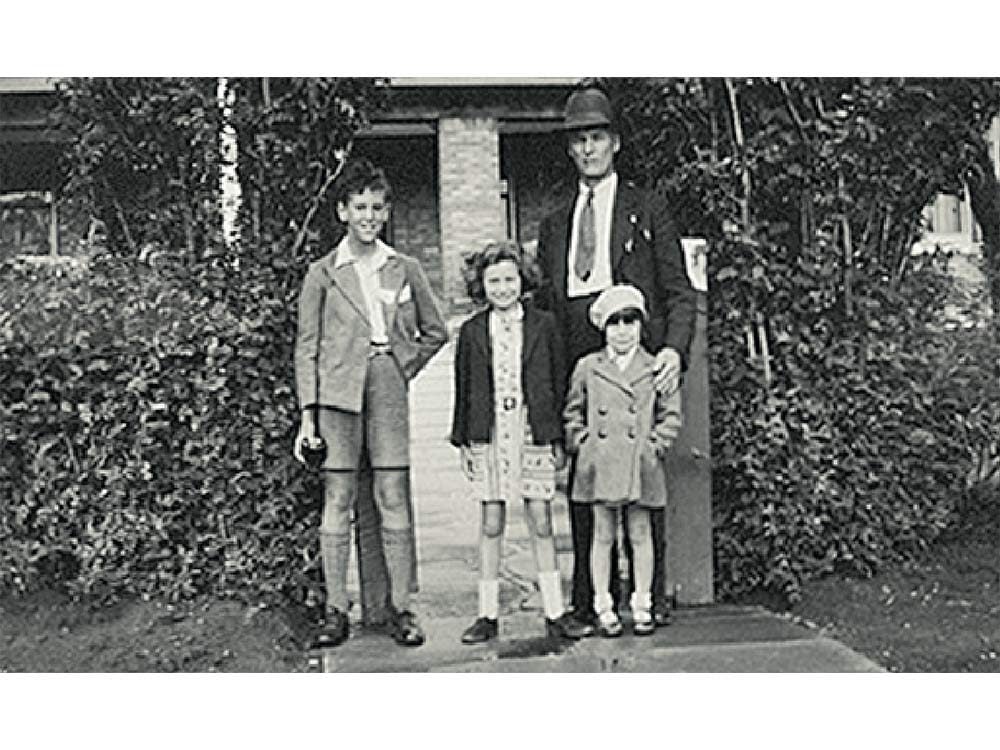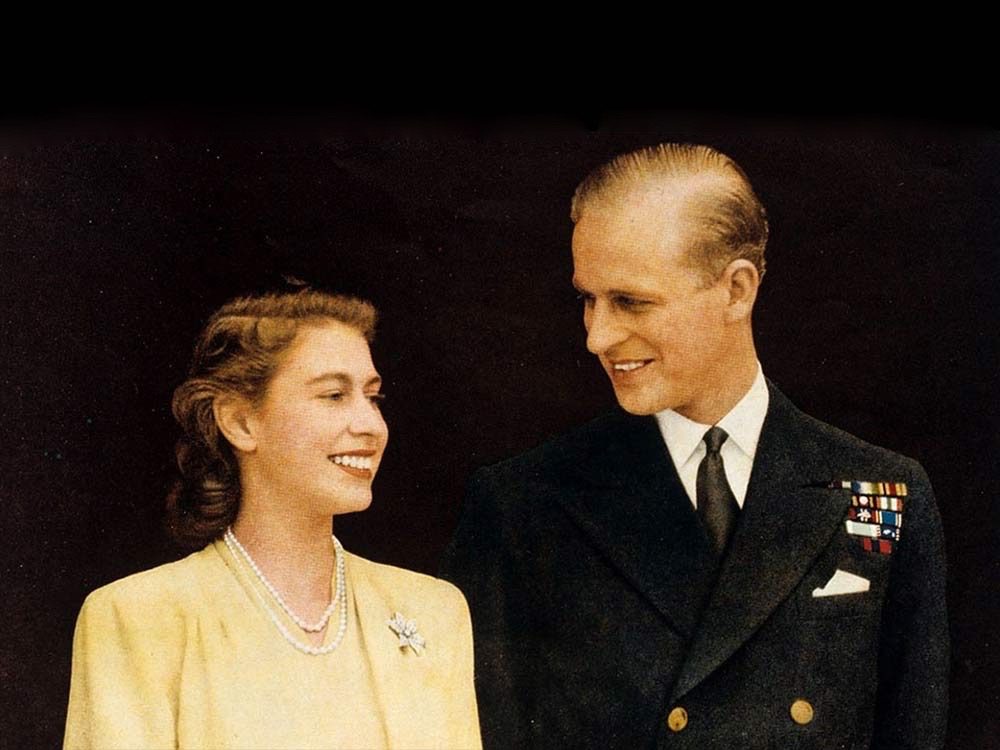
Canada: A Safe Haven from The Blitz
In 1937 my parents decided to leave Regina and return to England, taking my two-year-old self with them and settling in London.
Unfortunately, by 1940 Britons were at war. The sound of air raid sirens became common, shelters sprouted at the bottom of the gardens, and blackout curtains and gas masks were mandatory. Families began sending their children to the north of England to escape the bombings and not long after that I became one of a boatload of children crossing the ocean to safety in Canada.
To a five-year-old child, the crossing was rather an adventure. I learned later that I was on the last ship to make the crossing. The next one was torpedoed and went down in the Atlantic; no more evacuees were sent over after that. (One Canadian remembers the sacrifice of soldiers during The Battle of Dieppe.)
Canada was a wonderful place for children who had been living with blackouts and rationing. Although my parents had expected me to go to members of my mother’s family, I was taken instead into the home of an elderly (to me) bank manager and his wife, Edwin and Emma Nelson. They had never had children of their own, but they took care of me with tremendous kindness. I was settled in Kerrobert, Sask., where schoolchildren in particular found me a novelty and my English accent a wonderful source for mimicking.
Meanwhile, my father had enlisted in the RAF and my mother worked in a munitions factory. Letters flew back and forth to keep us in touch. Foster families took great pains to keep the memories of home alive in their young charges. Also, the CBC cooperated with the BBC to broadcast messages from parents to their children overseas.
I still have a game put out by the CBC called Carrying the Tools to Britain. It is dog-eared from constant use as I moved the cardboard pieces representing food supplies, tools, arms and so on across the breadth of Canada to the Atlantic Coast and then to England. Perhaps I thought I was helping to win the war and bring my parents back to me.
It was five years before we were together again. My parents chose to return to Canada. It was only as I grew older that I began to realize the loss of those five years. My parents also never lost a sense of guilt that they had sent me away and missed those growing-up years. Yet they and all the others only did what seemed best at the time.
On Remembrance Day, I think of all those people, like my parents, who soldiered on bravely in the confusion of the bombings, shortages, daily tragedies and separation from those they loved, who kept “a stiff upper lip“ and a smile through it all and then picked up and started all over again without grumbling.
Plus: This Letter From a Canadian Soldier Explains the Sacrifice of Veterans Everywhere

Prince Philip’s Cute Nickname for Queen Elizabeth
Coming up to their 70th anniversary, Prince Philip and Queen Elizabeth II have gone through their ups and downs. But one little fact about their relationship in particular gives us the warm fuzzies. (Here’s what really happened when Jackie Kennedy met Queen Elizabeth.)
Most couples have cutesy nicknames for each other, and the Duke of Edinburgh and Her Majesty are no exception. Apparently, even royal couples have silly little relationship quirks. (This is how much each person in the British royal family is actually worth.)
During the 2006 film The Queen, Philip is about to get in bed and tells his wife to “move over, cabbage.” Wait…cabbage?
“I inquired in royal circles and was told on very good authority that that is what the duke sometimes calls the Queen,” said the film’s screenwriter Peter Morgan tells The Times. The Queen’s biographer, Robert Lacey, confirmed. How cute!
Some have speculated that the pet name comes from mon petit chou, a French way of saying “my darling.” In English, though, the term translates literally to “my little cabbage,” though it actually comes from a shortened term for the pastry chou à la crème. (Check out these other French phrases everyone should know.)
But “cabbage” isn’t the only nickname the Queen has. Prince George calls her “Gan-Gan”—as British royals have been doing for their great-grandmas for generations, according to PopSugar. And when she was young, the then-princess’s close family would call her “Lilibet,” mimicking the fact that she couldn’t pronounce her own name. (Don’t miss these other fascinating facts about Queen Elizabeth.) Still, Prince Philip’s nickname for her just might take the cake as cutest nickname.
For more royal facts, find out the sweet reason Queen Elizabeth always wears neon outfits.
You’ve been making scrambled eggs all wrong. Here’s the right way you need to try.
Saturday mornings aren’t complete without a steaming plate of light and fluffy scrambled eggs (crispy bacon and buttery toast optional but definitely recommended). Yet it’s easy for this beloved weekend essential to become a crusty, dry, lifeless lump of overcooked dull yellow eggs. (You can also try these tricks for making other kinds of eggs.)
Turns out, the problem might not depend so much on your talents in the kitchen; everything from the type of pan you use to what you add to your eggs could be the reason why you end up with disaster instead of delicious.
Alex Guarnaschelli, celebrity chef, Food Network star, and executive chef of Butter in New York City, told us just what it takes to create the perfect plate of scrambled eggs.
If you’re using anything other than a nonstick pan, that’s your first mistake. You might love your trusty cast iron but it’s beautiful for cooking just about everything except scrambled eggs. Even with a ton of cooking fat or a well-seasoned pan, there’s something about the cast iron that makes eggs want to stick, meaning you’ll end up with less eggs and a caked on mess to scrub later. “A nonstick pan and some butter is the best combo to make the eggs cook evenly,” says Guarnaschelli.
Speaking of butter, put it in a pan and let it melt on mellow to medium heat (don’t let it turn brown!) Meanwhile, whisk the eggs in a bowl with Guarnaschelli’s tried and true recipe: a pinch of salt, cracked black pepper, and a splash of cool water to loosen them up. Don’t make the mistake of adding milk or cream, no matter how creamy you like your eggs. “To make fluffy scrambled eggs, the best trick is to whisk in a splash of water and nothing else. Cream, milk, and other liquids drag the eggs down!” she says.
If you crave a little more flavour, take a page out of her mother’s book (she happens to be an esteemed cookbook editor) and whisk in a couple drops of hot sauce and Worcestershire sauce. “It’s the perfect combo to elevate the egg flavour slightly without overpowering,” says Guarnaschelli. “I love freshly grated Parmesan cheese, too.”
Once the butter is melted, pour in the eggs. The pan should be hot but not piping hot, since too high heat is what leads to overcooked and dry eggs. You might want to immediately start stirring, but don’t. Instead, allow the eggs to settle and cook for a minute before starting to gently stir them with a heatproof rubber spatula, which will not only protect your pan from scratching but also prevent them from turning into a mushy mess. “I stir consistently, sweeping the sides and edges to make sure the egg doesn’t stick and cook too quickly in only one area,” says Guarnaschelli. “Being consistent and watching them is the most important part of the method.”
When your eggs reach their desired consistency, immediately remove them from the heat and transfer to a plate. If you don’t, you run the risk of ruining that perfect pile you just worked so hard to create. “They will continue to cook as long as they are in the pan, even if you remove it from the direct heat of the stove,” she says.
Finally, one last rule before digging in. “I scramble the eggs when I am ready to sit down and eat. Scrambled eggs are so simple but they don’t wait or taste better cold!” says Guarnaschelli.

Helping trees grow
Environment Dutch engineer Jurriaan Ruys has invented an ingenious way of restoring vegetation to arid regions of the world. His cheap and simple ‘cocoon’ allows young trees to survive long enough in dry conditions to establish root systems. And it’s proving extremely successful.
Just three years after he completed the first prototype, his invention has been adopted in 20 countries around the world, with 250,000 trees planted.
The cocoon is shaped like a doughnut and made from biodegradable waxed paper. Each sapling is planted in a holder through the center, with enough water to sustain it in its first months. The water is fed to the tree via a wick, but only in small amounts, so the tree is encouraged to put down roots. “We know if we can get them through the first one or two years, they will survive,” says Ruys.
In a recent project in the desert regions of Spain, where other attempts to grow trees had managed a success rate of only 10 to 20 percent, the cocoon provided a 95 percent survival rate.
Gay convictions overturned
Society The German parliament has voted to quash the convictions of 50,000 men who were sentenced for homosexuality under a 19th century law that was rigorously enforced during the Nazi era—and which continued after World War II.
“Back then, you lived with one foot in prison,” remembers 74-year-old Fritz Schmehling, who was convicted under the law as a teenager. He is one of around 5,000 men who fell victim to the statute who are still alive. All will now receive a lump sum of 3,000 euros, as well as 1,500 euros for each year they spent in prison.
The change comes after decades of lobbying by victims and activists. Registered partnerships between same-sex couples were legalized in 2001 in Germany, but the country has yet to grant the full marriage rights found in many EU states.
Combating urban poverty
Welfare Barcelona, Utrecht and Helsinki are taking part in a novel social experiment aimed at alleviating urban poverty. The poorest residents will be given grants in different forms by the EU for two years to lift them above the breadline.
The idea is to find out what difference is made to a household once the basic costs of living are covered, with the ultimate goal of developing more efficient welfare services.

Blinded pilot beats the storm
Heroes The Airbus A320 with 127 passengers on board was just 10 minutes into its flight from Istanbul to Cyprus when it encountered a violent freak storm. Hailstones the size of golf balls lashed the plane, destroying its nose, smashing its windshield and disabling its autopilot.
Despite losing vision from the cockpit, Ukrainian captain Alexander Akopov didn’t panic. The veteran pilot asked permission from Istanbul’s Ataturk airport to return and attempt a ‘blind’ landing.
As the plane approached the runway, passengers screamed in fear for their lives. But Captain Akopov used his experience, relying on instrument readings and guidance from the control tower, and brought the plane home safely—to applause from waiting emergency services.
“The passengers are alive. It is normal. This is our professional reliability,” the modest hero said afterwards. He has since been awarded Ukraine’s Order for Courage.
Sources: Environment, The New Yorker, 11.7.17. Society: The Guardian, 22.6.17. Welfare: The Local (Spain), 1.6.17. Heroes: Daily Telegraph, 31.7.17

Tim Seidell on goals
“I won’t be shaving this November, in order to raise awareness for how lazy I am.”
Myq Kaplan on honesty
“‘I have a beard’—a bald-faced liar.”
Here are 13 things you didn’t know about moustaches.
Ron Babcock on public perception
“When is your beard too long? When the comments turn from ‘Hey, I really like your beard!’ into ‘Hey…a beard!'”
Jackie Flynn on progress
“Do you think shaving cream really softens your beard… or is it just so you don’t lose your place?”
Here are four amazing uses for shaving cream—aside from shaving, of course!
Hannibal Buress on expectations
“If you’ve got a handlebar moustache, don’t talk to me like you don’t have a handlebar moustache. All I want to hear you talk about is Slinkys and kazoos and that’s it.”
Plus: 8 Recent Beauty Trends That Should Have Never Happened
Chris Hardwick on style
“Hipster nerds don’t appreciate things…even their curlicue moustaches look like a shrug. ‘Meh, I don’t wanna be on this guy’s face, either, but I can’t cut myself off!”
Check out these grooming products every man should get.
Sean Morey on the obvious
“My friend was looking at an old picture of me without a beard, and asked, ‘Did you grow a beard?’ No, I shaved my photos.”
If you laugh at these dark jokes, you’re probably a genius.
Dan St. Germain on power
“I was thinking about getting rid of the beard, but I’ve had it for so long that at this point it makes the decisions for me.”
Here are the 70 most LOL-worthy jokes in Reader’s Digest history!
Jimmy Kimmel on direction
“I learned that if you follow a man with a beard, he will lead you to a panel discussion on increasing your social media presence.”
Plus: 15 Fascinating Facts About Moustaches to Celebrate Movember

What is Movember?
Every autumn, you’ll notice more and more men ceasing to shave their facial hair. However, their uninhibited moustache growth isn’t out of laziness or part of some fall trend. Starting November first, men are encouraged to participate in “Movember,” a month-long campaign to raise money and awareness for men’s health issues.
The idea for Movember was born in 2003 in Melbourne, Australia. In the first-ever Movember challenge, a group of 30 Aussie friends (self-proclaimed “Mo Bros”) challenged each other to grow out their moustaches for an entire month, simply to see if they could bring the style back to popularity. Surprised by their bold moustaches’ ability to spark conversation, the founders decided to attach the challenge to a worthy yet overlooked cause: men’s health and The Movember Foundation was born.
Today, The Movember Project draws international participants from America, Europe, South Africa, Canada, New Zealand, China, and more. Since its humble beginning with only 30 entrants, there have been over 5.2 million Movember participants, and a whopping $710 million has been raised. Over the last 13 years, 1,200 men’s health projects have been funded with record-setting donations.
Movember still aims to generate conversation and increase awareness about prostate cancer (its original sponsorship partner), but today, the project is also focused on testicular cancer and mental health issues like depression and suicide prevention. Testicular cancer rates have doubled in the last 50 years, prostate cancer rates will do the same in the next 15, and 500,000 men take their own life each year. There is widespread stigma and silence surrounding these three health issues, but thanks to Movember, the state of crisis in which men’s health currently finds itself is being reversed.
To participate in Movember, simply grow out your facial hair every day during the month of November, start as many conversations about men’s health as you can, and raise money for the non-profit organization. Some challengers ask friends and family to donate a dollar every day they grow out their ‘stache, others take bids on what colour to dye it, and many simply donate the money they would have spent on shaving materials that month. If you want to participate, yet can’t grow a ‘stache for whatever reason (your work doesn’t allow it, for example), check out the similar, yet more lenient program No-Shave November.)
The fundraising options are endless and can be wildly creative, but one thing is certain: Movember is an incredible way to break the silence and stigma surrounding men’s health on a global scale. To kick off and celebrate the start of Movember, here are 15 fascinating facts about moustaches.
1. The King of Hearts is the only king in a deck of cards without a moustache.
2. The average man spends six months of his life shaving and moustache grooming (assuming he begins around 15 and lives to be around 75).
3. In Eureka, Nevada, it is illegal for men with moustaches to kiss women.
4. Police in India’s Madhya Pradesh state are sometimes paid bonuses to grow their moustaches, because they’re believed to command more respect. (The royal past lives on behind India’s palace doors.)
5. How’s this for moustache grooming? Noblemen in the Victorian era at soup with special “moustache spoons” equipped with small barriers to protect their moustaches, according to uselessdaily.com.
6. In 1967, The Beatles included cardboard moustaches in their album, Sgt. Pepper’s Lonely Hearts Club Band, because the band members were all sporting moustaches on the cover.
7. The first historical artifact depicting a moustache dates back to 300 B.C. It shows an Iranian horseman with a thick, black moustache.
8. A study by the University of Southern Queensland in Australia found that facial hair can protect skin and prevent skin cancer by deflecting 90 to 95 per cent of harmful UV rays.
9. There are between 10,000 and 20,000 hairs on a man’s face, and the average moustache has 600.
10. According to Guinness World Records, Ram Singh Chauhan holds the record for longest moustache, spanning 14 feet long. He has been growing it since 1982, after a friend with a 7-foot-long moustache suggested it.
11. Moustaches are capable of absorbing 20 per cent of their own weight in liquid, which makes them very handy in the event of spillage.
12. The average man will touch his ‘stache upwards of 750 times per day, averaging 31.25 times per hour.
13. Alexander the Great made all his soldiers shave their moustaches before the battle of Ardela.
14. The World Beard and Moustache Championships have taken place annually since 1990, and Anchorage, Alaska has sent a record number of entrants.
15. Albert Einstein was not seen without his moustache for over 50 years.

Ever heard of a lamplighter? Up until the early 1900s, gas lamps lit up streets, and these lamps didn’t light themselves. Lamplighters would climb ladders and then strike matches to light each lamp. But once electric street lights came along it was lights out for those guys. Unfortunately, there are many jobs today that will being going the way of the lamplighter, the telephone operator, the toll collector, and other jobs we no longer need. Automation and technology are replacing them, whether by faster means of doing the job or rendering the job obsolete. (These weird workplaces will make you glad your job is normal.)
Common jobs that are slowly disappearing
Over the next five years, The World Economic Forum estimated automation will cost 5.1 million people their jobs. That’s a lot of people out of work, but it really depends on what you do. Here are the jobs at the highest risk for extinction:
- Fast food cooks
- Accountants
- Construction managers
- Auditors
- Truck drivers
“Often jobs we see on the decline are ones where technology or automation have become more prominent,” says Rosemary Haefner, chief human resources officer at CareerBuilder. “For example, in the case of fast food restaurants, there is technology on the rise that is automating the preparation process.” According to The Los Angeles Times, half of America’s truckers could be out of a job within the next ten years due to fully automated trucks. Zerohedge.com noted that it’s already happening. Otto, an automated trucking company now owned by Uber, has already delivered beer and has been approved to travel two routes in Ohio.
A need for skilled workers
It seems that jobs that are on the upswing are those that require a higher level of skill set. For instance, Forbes noted the need for more physicians especially in geriatric and psychiatric care as baby boomers age. With a starting base salary of $200,000, becoming a doctor sounds pretty good if you’re willing to hit the books to obtain that medical degree. But wait! There’s a catch: It could cost $300,000 or more to earn that degree in the first place. (These female CEOs share the best career advice they’ve ever received.)
Computers can’t do it alone
According to Forbes, when it comes to marketing, social media and the Internet has provided vast new opportunities. However, determining where to spend those advertising dollars so companies reach the right audience is more tricky. A computer can help, but someone still needs to interpret data and make recommendations.
Look for new opportunities
Whether or not you should worry about your position is really dependent on your field and expertise, but it might behoove people to keep an eye out for opportunities that materialize from these changes. (Here are three reasons why you should quit your job right now.)
“We know from our research that only one in ten people say they are afraid robots are going to take over their job. There will always be a need for human interaction across all industries,” says Haefner. (Here are 11 words you should always say in a job interview.)
Be flexible
A flexible position may be easier to find and, according to Flexjobs, have real earning potential.
“Flexible work options like remote work and flexible schedules are increasingly common. But some of the biggest myths about them are that they are all lower-level jobs, or that they don’t pay well, or that they’re only available in fields like data entry and software development,” says Brie Reynolds, Senior Career Specialist at FlexJobs. “The truth is that there are a wide variety of flexible, lucrative jobs out there, many of which might surprise people.
According to their job-finding data, current flexible positions such as a technical recruiter were offering up to $130,000 a year, while both a music instructor and a medical writer were paying $45 per hour. (When speaking with your boss, never say these nine things.)
Plus: Why Women Make the Best Bosses, According to Science

Duchess Kate Speaks Out On Mental Health
We all love Duchess Kate for her beauty, her elegant style, and her enviable romance with Prince William. (Although this is why they never show PDA.) But like Princess Diana before her, there’s more to this royal than her stunning smile and fashion sense. She’s taken up the torch—or should we say the crown—to advocate for important charitable causes around the world.
Most recently, the Duchess of Cambridge has teamed up with the Anna Freud National Centre for Children and Families, a charity that provides training and support for child mental health services, to tackle the issue of mental health. The Duchess introduced a short animated film, which hopes to help young children and their parents have more honest conversations about mental illnesses.
“Mental health is how we feel and think, things that can’t really be seen but that affect us every day. And talking about them can feel difficult,” she said in the film.
Besides defining the term “mental health,” the animation provides advice for children and adults on how to communicate and address personal thoughts, emotions, and moods. Unlike physical health, mental health is often invisible, which requires people to honestly talk about their feelings with others. (If you think you have depression, read this.)
The Duchess explained that the short film can help young children parse out “what to say and who to talk to when we have feelings that are too big to manage on our own,” she said. “Sometimes it’s just a simple conversation that can make things better.” Well said, Princess Kate.
As for her own views on parenthood? She and Prince William always follow these etiquette rules—as does everyone in the royal family.
Plus: This is How Much Each Person in the British Royal Family is Actually Worth

Anne Boleyn
King Henry VIII’s second wife, Queen Anne Boleyn, was beheaded by sword in the Tower of London on May 19, 1536 after she was accused by her husband of adultery and incest with her brother. Perhaps innocent of her crimes, Anne’s restless spirit has been rumoured to roam by the Queen’s House, near where she was executed. She has also been spotted at the head of a procession of Casper-like lords and ladies at the Chapel Royal of St. Peter and Vincula. She is buried beneath the Chapel’s altar. Her headless body has also been spotted gliding across the corridors of the Tower. And according to HistoricUK.com, on the anniversary of her death, Anne has made an appearance at Blickling Hall in Norfolk, where she may have been born. Read more about famous ghost stories with logical explanations.
Queen Elizabeth I
Anne Boleyn’s daughter never married and ruled Britain for 44 years and has never really left. The Virgin Queen has been spotted in Windsor Castle floating from the royal library to an inner room. Other members of the royal family have said to have interacted with this most famous monarch’s spirit. Both King George III and King Edward VII, said they saw a woman dressed in a black down who may have been the Queen. In fact, King George III supposedly spoke to the most royal of ghosts where she told him she was “married to England.” But King George VI, father to Queen Elizabeth II, has them both beat as he has claimed to have seen the Tudor Queen eight nights in a row upon the onset of WWII. Most recently, Steve Wesson, in an investigation with UK Ghost Hunts, visited Strelley Hall, in Strelley, Nottinghamshire and claimed to have captured Queen Elizabeth I hovering in a cellar archway on film. Supposedly she’d slept in Strelley Hall at one time. Find out the most haunted places in Canada.
Catherine Howard
Not to be outdone by her executed predecessor and second cousin, Anne Boleyn, Queen Catherine was only a teen when she became King Henry VIII’s wife and only a mere 19 years old when she was killed for the same reason as Anne: adultery. Although she may have been cheating on her very much older and sickly sugar daddy of a King, and affairs are no stranger to the modern royals as well, it was considered treason. Young Catherine begged to speak with Henry VIII after escaping her apartment in Hampton Court where she’d been imprisoned, only to be dragged back by the guards. She never did get to plead her case to her husband. Perhaps that is why she has been spotted running down the “Haunted Hallway” screaming and crying.
Prince Edward V and Prince Richard, Duke of York
These two young boys were taken to the Tower of London in 1483 because King Richard III did not want his nephews to usurp him as king. Only 12 and 9 years old when they were locked away, no one really knows what became of them, although some believe they were likely killed. Their apparitions can be spotted staring from the windows of the ghostly tower. According to Haunted Places in the World, “the princes have been spotted in the Bloody Tower wearing white nightgowns and holding hands. They never make a sound and can only be seen for a few fleeting moments before they fade into the stonework.” Read on for Canada’s best haunted walks.
King Edward VII’s Secretary
The royal family is no stranger to stories of scandal, you need a thick skin to survive—or not. Although it may not seem like a big deal, back during King Edward VII’s reign from 1901 to 1910, his private secretary, Major John Gwynne, caused quite a stir when he divorced his wife. Conscious uncoupling may be a thing today but back in the 1900s divorce was a big no-no. Major Gwynne couldn’t handle the scrutiny and rumours. After being shunned by his upper-crust peers, the pressure got to him and he took a bullet to his own head in the first-floor office of Buckingham Palace. The Queen’s official workplace staffers have reported a strange aura in that room and supposedly a single gunshot has been heard coming from that room.
Dame Sybil Penn
As nurse and servant to Prince Edward and Queen Elizabeth I, it is likely that Dame Sybil Penn would have been exposed to lots of germs in Britain. In 1562, she succumbed to smallpox and died, but as a faithful servant and caregiver, she continues to visit the Victorian family at Hampton Court Palace—although according to palace officials she didn’t start appearing until the 1800s when Hampton Church, where she was buried, was taken down. Since then, she is said to frequently appear among the various rooms within the 16th-century palace. Onthetudortrail.com notes that “after Sybil’s resting place was disturbed, people began hearing the sound of a spinning wheel from behind a wall of the southwest wing of the palace. Upon further investigation, an old chamber was discovered and inside lay an antique spinning wheel.”
Queen Victoria
King Edward VIII let his brother take the crown instead of him—for love. Quite the scandal in 1936, his romance with the still-married Wallis Simpson from the United States was the reality TV of its time. Ms. Simpson had grand ideas for Windsor Castle and attempted to remove spruce trees planted by her lover’s great-grandparents, Queen Victoria and Prince Albert. As the story goes, the trees were never removed as the workers were scared away by the clearly unhappy spirit of Queen Victoria waving her arms and moaning loudly. Read on to learn more about the most haunted hotels in North America.
Saint Henry Walpole
Anmer Hall in Norfolk is part of the Queen’s Sandringham estate and was a gift to her grandchildren, the Duke and Duchess of Cambridge. Besides a complete overhaul to bring the house back to its Georgian-era roots, Kate and William were also given its ghostly occupant, Saint Henry Walpole. The Walpole family originally owned the estate, but Henry’s life did not end well. He was tortured at the Tower of London for his Catholic conversion and finally hung in 1595. His spirit is said to haunt the grounds of his old home. According to Express, the royal couple didn’t have an issue with sharing their home with a ghost and instead said, “No old home would be complete without its ghost.”
King Henry VIII
Said to be Queen Elizabeth II’s favourite place to live, Windsor Castle must also be the favourite of King Henry VIII as he hasn’t seemed to have left even though he died hundreds of years ago. Many witnesses have spied his spirit wandering amidst the rooms of the castle looking despondent and agitated, specifically, “a large man pacing furiously and shouting loudly.” Since he beheaded two of his wives and had many others executed on his orders, this may be one majestic spirit to avoid.